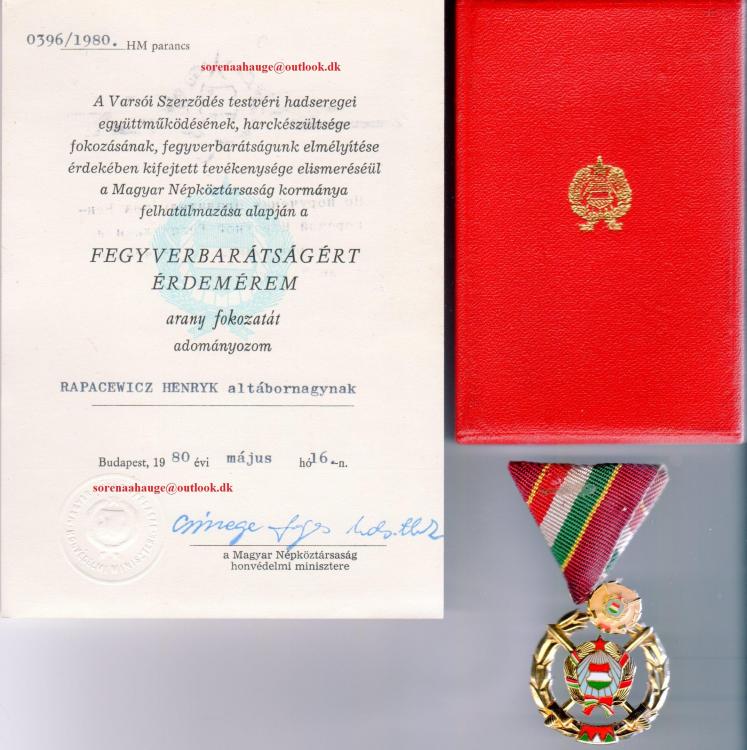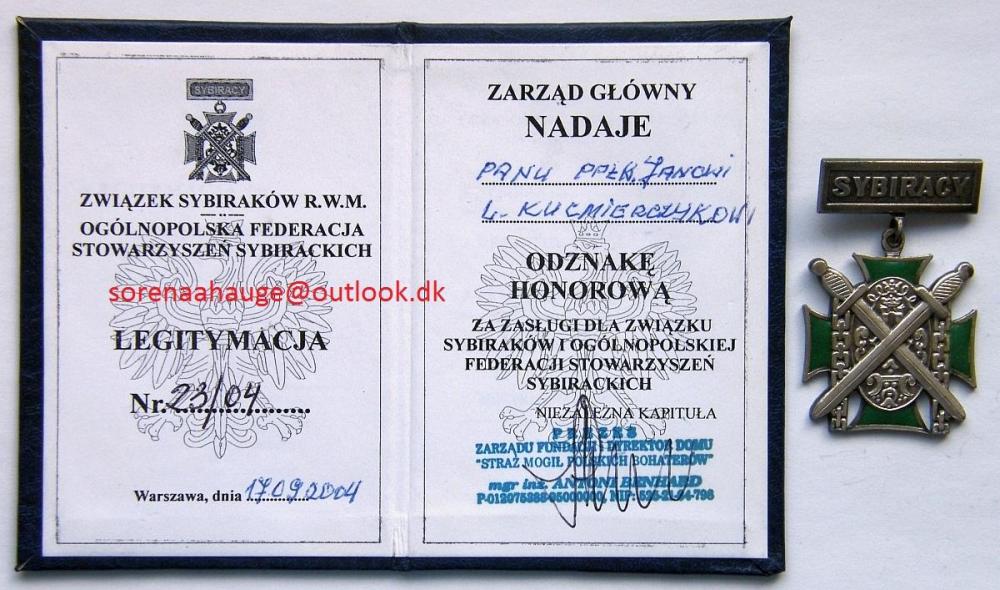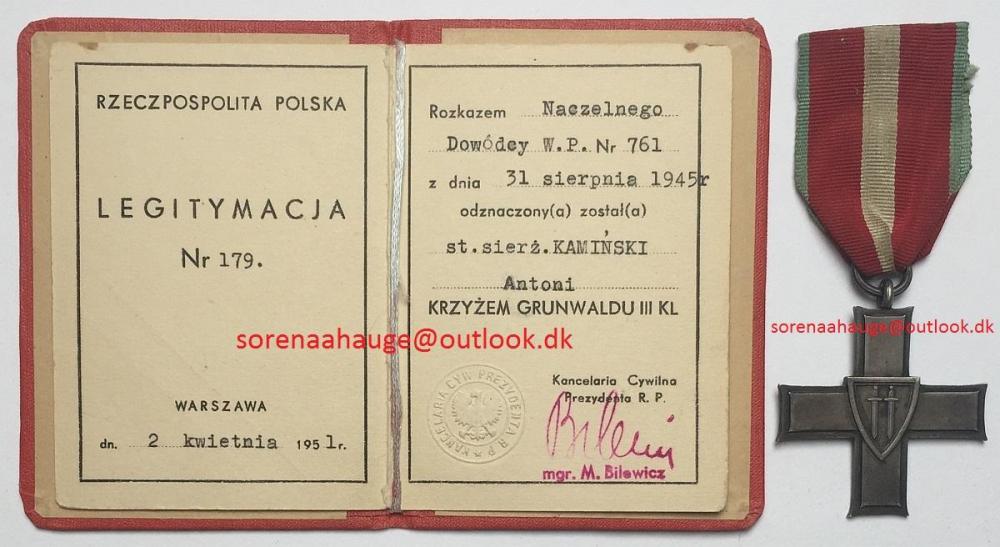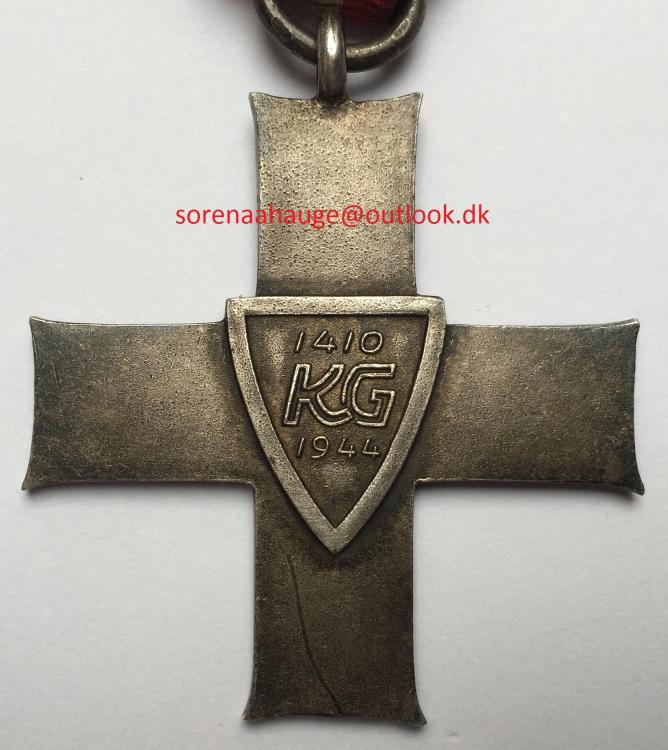
Aahauge
Standard Membership-
Posts
34 -
Joined
-
Last visited
Content Type
Profiles
Forums
Blogs
Gallery
Events
Store
Everything posted by Aahauge
-
Polish Partisan Cross (real?)
Aahauge replied to BalkanCollector's topic in Central & Eastern European States
hehe, not too bad a price then ? -
Polish Order of Polonia Restituta
Aahauge replied to Alex .'s topic in Central & Eastern European States
It's the socalled "Stalin" type. Dull gilt but still very gold-like in colour. It was produced from around 1953 by the National Mint in Warsaw. As stated above it's 4th Class. Actually the 4th Class is around 55.6mm (depending on version) and the 5th Class is only 45mm. So besides the rosette there's also difference in size ? Best regards Aahauge -
Polish Partisan Cross (real?)
Aahauge replied to BalkanCollector's topic in Central & Eastern European States
Bit difficult to see exact details from your photos, but to me it looks like a genuine Type 1 (Grabski). Size should be 38.5mm and the "eye" for the ribbon-ring is circular with a hole drilled through (and soldered on). Only 20.750 of this type were awarded and it's the most expensive type. The one you depict is in a bad shape with a lot of scratches, so I guess price would be around 50-60 usd. But that's me guessing. Best regards Aahauge -
Hungarian medal 1980 - need info
Aahauge replied to Aahauge's topic in Central & Eastern European States
Thx again Eddie, Now I can visualize how the circular mini-device was used. I know that the actual medal was fastened to one of the long metal bars, he used on official occasions, when he wore all his decorations - and I'm also fairly certain that he never attached the miniature to his ribbon bars. He had some 40+ ribbons on his bars, and probably didn't think much about this minor detail. Best regards Aahauge -
Hungarian medal 1980 - need info
Aahauge replied to Aahauge's topic in Central & Eastern European States
Thx Eddie! Just the sort of info I was looking for ? . I'm used to Polish medals, so the miniature confused me a bit.....in Poland they come with a ribbon (either cloth or enamel), but aye, my mini has the same sorts of pins for fastening, so guess the general just clamped it around the medal ring to not loose it ? Best regards Aahauge -
I think this is some kind of "Brotherhood in Arms" medal. I need a bit basic info: 1) The English name of the medal. 2) The purpose of the small, circular device attached between the ribbon and the medal - is it just a miniature or did it add some purpose/explanation for the full size medal (and hence was supposed to be attached to the medal). 3) Rarity. This medal came with a large group for a Polish Major General (gen.dyw.) Henryk Rapacewicz, that I bought a few years ago. He held quite a few important offices during Communism: Commander of the Silesian Military District (SOW) and during Martial Law from 1981-1983 he was a member of the 23 man Council for National Salvation (WRON), that de facto held all power in Poland. Best regards Aahauge
-
Poland Polish documented group to Stanislaw S. Stefana
Aahauge replied to RedMaestro's topic in Central & Eastern European States
His name is Stanislaw Sobczyk (son of) Stefan as implied above. You got the Standard of Labour, 2nd Class (left) and Cross of Merit, silver (Krzyz Zaslugi, right). If you look at the documents, right side top, you'll see some text. The word of most importance here is the last: górnictwie, which means "mining". So Mr. Sobczyk worked in the mining industry and received these medals for long, impeccable service. The Order of the Standard of Labour, 2nd Class was awarded for 20 years (dwudziestoletnia). The Cross of Merit, silver, was awarded for 10 years (dziesiecioletnia). He would also have received Cross of Merit, bronze, for 7 years and Cross of Merit gold for 15 years. Best regards Aahauge -
Poland Polish Red Cross Decoration of Honour 1st Class
Aahauge replied to Brian Wolfe's topic in Central & Eastern European States
Hey Brian, Aye, you bought the 1st class back in 2008. It is indeed from the Communist PRL times and probably from the 1980s. There were actually 4 classes: 1st class gold 45mm; 2nd class gold (36mm); 3rd class silver (36mm); 4th class bronze (36mm). On the award documents will be stated the class only like 1st, 2nd etc. (I have attached a document for a 2nd class gold with a 2nd class gold medal (36mm) awarded to Major General Henryk Rapacewicz, commander of the Silesian Military District (SOW). From 1945/46 - 1989 there were at least 4 different versions all made by the National Mint. First version had engraved "P.C.K. Zasludze" on reverse. All PRL versions had identical design and un-crowned eagle - only the reverse differs. Best regards Aahauge -
Poland infos about polish orders and medals
Aahauge replied to seb16trs's topic in Central & Eastern European States
All medals and documents shown in this thread are genuine. No worries. Since this thread is very old, I won't spend time on detailed comments - unless there's still an interest? Best regards Aahauge -
Hey Noor, Can't open your photo, but those 4 medals would normally go together. The Warsaw, the Nysa and the Freedom were awarded to WWII veterans (in Soviet service) and if he stayed in the army until around 1965, he then would have gotten the 20 years too. The only curious thing is, that if he stayed 20 in the army, then he would have picked up more medals along the way (at least long service 5 years and Long service 10 years). Those ribbon bars should have been present too. Best regards Aahauge
-
Poland Polish 1 WDP Kosciuszco Badge
Aahauge replied to rakkasan's topic in Central & Eastern European States
Hello Rakkasan. The badge looks genuine - low quality as used in late 1970s / 1980s. There's a least 3 official versions + a few sub-versions. The one u got has a screwplate from the National Mint, which was the maker for ages. I'm writing books on Polish medals and badges, and if you still need further information, I can check my files. Best regards Aahauge -
Poland Polish Communist Group - Genuine or Fantasy?
Aahauge replied to vladtheman03's topic in Central & Eastern European States
seems genuine. Sometimes ppl by accident received 2 medals - in this case Victory and Freedom. Most often it was due to two different authorities awarding the medal on the same occasion. If you had the documents you would probably see that one was awarded by the government and one by Kadr MON. Ribbons and sequence seems allright - a little confusion or misplacement is allright on this "actual" medal bar as opposed to a plain ribbon-bar. When veterans received new medals they were often attached, where they found space......to be later relocated, which sometimes failed. The ribbon-bar was very official and I have never seen any misplacements. Best regards Aahauge -
Poland Poland - Order of Merit 1975
Aahauge replied to mrgasa's topic in Central & Eastern European States
Sorry for late reply. If you still have the medal please submit a photo + document. I will happily valuate it for you. Best regards Aahauge -
Polish - Order of Polonia Restitutia
Aahauge replied to a topic in Central & Eastern European States
Concerning the award booklet numbering (since I kinda lost track of all the other questions) The first sequence (242) is possibly a protocol number or a region/city number - tbh I have forgotten to ask in Poland ? The next sequence (79) defines the award year 1979. This rarely f.... up, but it happens. This doesn't really add up to rarity, but when the middle number doesn't correspond with the award year, it becomes a bit more interesting for document collectors. The final sequence (45) will normally define how many were awarded this year so far - in this case 45. To confuse things a bit, some orders have reversed the first and third sequence. But in this case I'm fairly certain that it was number 45 in 1979 awarded possibly in a region/city coded 242. As stated in some previous comments the Communist (PRL) version of Polonia Restituta had the reverse year 1944 and an uncrowned eagle (with a few rare exceptions). The order was awarded for everything valuable: like 30 years service in public offices and armed forces; "retirement-award"; exceptional merit for the state in the fields of education, culture etc etc. From 1944-1989 a total of 614.021 crosses (5th class as depicted above) were awarded. Especially during the years of 1971-80 and 1981-89 the order was massively awarded: 1971-80: 260.624 awards. 1981-89: 277.932 awards. If you have further questions, please ask ? I'm tracking this thread now. Best regards Aahauge -
Poland Poland Partisan Cross - Krzyz Partyzancki
Aahauge replied to IrishGunner's topic in Central & Eastern European States
Too much fake light on the cross to determine if it's genuine. Tons of obsolete crosses were sold by the National Mint to collectors, so it's only worth anything with an award document. Best regards Aahauge -
Poland Polish Iron Cross
Aahauge replied to Troy Tempest's topic in Central & Eastern European States
Well, this is another interesting topic. I do believe we have enough evidence to prove such a medal valid. There are a few pieces on museums in Poland. AK members had to kill an SS soldier during the Warsaw Uprising. A genuine Iron Cross (stolen from a dead German soldier) would have a coin soldered on with a quite crude engraving of AK and SS. I think I have seen a handwritten award document at some Polish Museum. The medal shoved above is ofc fake. A genuine would probably go for at least 4.000 USD. Best regards Aahauge -
Hello Gordon, Sorry for this late reply, but I just turned member, lol. Think Lukasz replied to this question in another thread? My personal opinion is, that the attachment has nothing to do with the Grunwald Cross at all. It's a crowned eagle and may hint at some "officers" or "reserve/veterans" association after 1990. Personally I would never remove it, because the recipient probably attached it himself for some reason. After the fall of Communism people started attaching all sorts of "organizational emblems" to their ribbons, possibly because they had no where else to attach them. They became members of Regimental Veteran Groups and received a membership badge.....why not place it on your bravery awards? Anyway - that is my personal opinion. Best regards Aahauge
-
Poland The Grunwald Awards of Poland.
Aahauge replied to Gordon Craig's topic in Central & Eastern European States
This is an old thread, but I dare reply anyway. The silver badge has never to my knowledge been awarded with a specific "silver class" document - and I have maybe 60 documents for all ranks from generals to privates. I have the same photo of Jaruzelski in my collection (b/w) and it seems by the shine to be a silver badge. None of the generals or colonels in my collection have received a silver badge - but to be honest they received high ranks in the 1960s. I tend to believe that all badges were bronze in their original issue, but at some point a "commemorative badge" in silver was presented to higher ranks.....as a commemorative award (not necessarily for participation in combat during WWII). I have a silver badge in my collection which seems old and genuine made by Makowski, if I remember correctly. There are a lot of silver badges on the market atm, but most are just "silvered" bronze badges - aka fakes. I am writing books about Polish medals and will of course continue to investigate this topic. Best regards Aahauge -
Poland Prison camp survivors given Siberian Cross by Poland
Aahauge replied to JPL's topic in Central & Eastern European States
Cross of the Deported of the Warmia-Masuria Region: Established: September 1998 by the Association of Formerly Deported to Siberia. Polish: Krzyz Deportowanych Regionu Warminsko-Mazurskiego. Awarded to members from the Warmia-Masuria Region of the Association for outstanding merit. In exceptional cases it could be awarded to non-members. -
Polish WW2 & Later Medal / Badge Group
Aahauge replied to vladtheman03's topic in Central & Eastern European States
Agree Lukasz (and nice to meet you again after some 10 years). I would point out out that the Odre, Nysa, Baltic document is interesting due to the w/z signature. Best regards Aahauge -
The cross looks like a Spink & Son issue. The stars? I don't know to be honest - need to check my collection, but may take some time. Best regards Aahauge
-
Poland The Medal of the Military Political Academy
Aahauge replied to nickstrenk's topic in Central & Eastern European States
Hello Nick, I do not have the medal unfortunately. It is a "desk-top" medal (a large circular medal, no ribbon), that was given to Warsaw Pact guests, who visited the Academy or to Polish officers, who was either educated at the Academy or functioned as a lecturer there. All medals from WAP are rare, since WAP officers were part of the Security Service. Unfortunately "desk-top" medals are rather cheap, so luckily for you it should be possible to buy the medal at low cost. I am writing books on "Polish orders and medals", so I would be interested in a good scan of the document. You can contact me at: sorenaahauge@outlook.dk Best regards Aahauge -
aye, Polonia Restituta, 3rd Class. Mid-late 1980s






